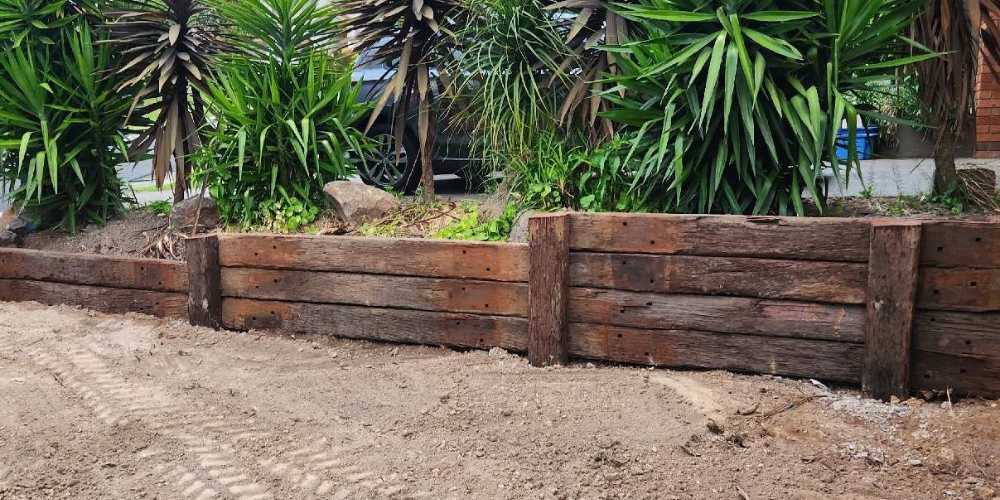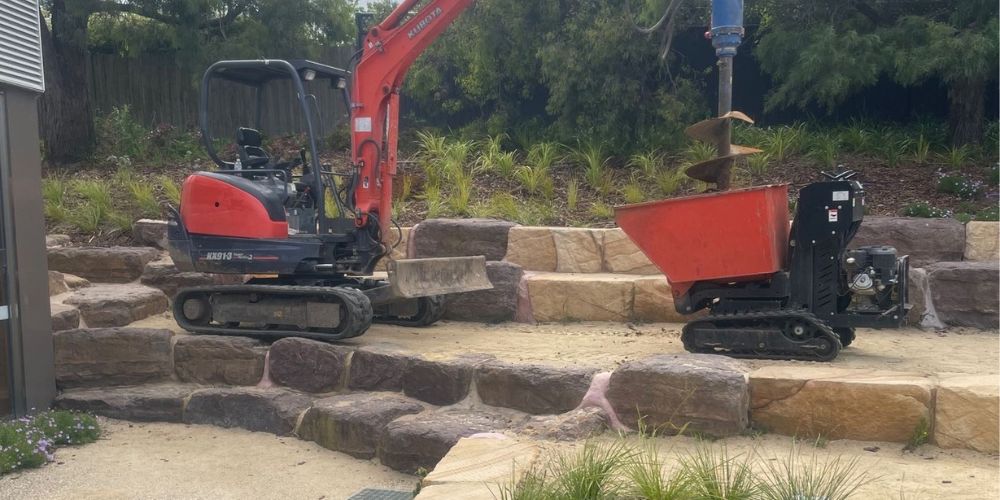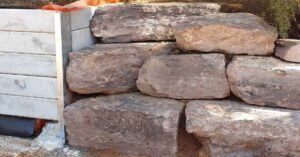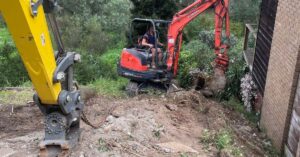Landscaping a Sloped Backyard – Is it Possible?
Homes and gardens on steeply sloping lands are unique. Even though some people find a sloping backyard challenging, the landscaping possibilities are well worth the work. Amazing views, long-term property value, and other benefits come with homes on sloping lands. With the appropriate techniques, you can also have a lovely, low-maintenance garden on a sloping property.
Although there are numerous issues to consider when landscaping a steep slope, the aesthetic possibilities are also intriguing. Although hiring a professional would make the job much simpler, landscaping your sloping backyard can be easy.
Join us as we explore sloping backyard landscaping and learn the secrets to success. Let’s dig in and learn how to transform your rough terrain into a stunning outdoor refuge to make the seemingly impossible feasible.

How to Landscape a Sloped Backyard?
Evaluate the Slope
It’s essential to carefully evaluate the slope before beginning any landscaping job. Consider the slope’s qualities and degree, whether mild or steep, since this will greatly impact how you landscape the area. You can properly plan and design your landscape if you know the slope’s special characteristics.
Plan and Create
Spend some time creating a thorough layout and design for your sloping backyard. Establish specific aims and objectives for the area while considering functional and aesthetically pleasing features. By visualizing the intended result, you may design a unified and harmonious landscape that makes the most of the slope’s beauty and usefulness.
Retaining Walls and Terracing
Using terraced levels or retaining walls is one of the primary landscaping techniques for a sloping garden. They stabilize the slope, provide level spaces for planting or outdoor activities, and enhance the aesthetic appeal of the environment, among other things. Create a variety of distinctive and useful places in your sloped backyard by adding terraces or retaining walls.
Choose the Right Plants
It’s crucial to consider slope factors when selecting plants for a sloping garden. Choose plants with deep root systems that are suited to slope situations. These plants have several advantages, such as preventing erosion, stabilizing the soil, and absorbing water. Additionally, consider choosing native plants better suited to a sloping landscape since they are more low-maintenance and naturally adapted to the local environment.
Prepare the Soil
For a sloping landscape to be successful, proper soil preparation is essential. Address soil erosion and nutritional deficits by incorporating organic matter and soil amendments. This boosts fertility while also enhancing drainage and soil structure. Your slope landscaping will be successful over the long run if you improve the soil’s quality since it creates the ideal habitat for plants to develop and thrive.
Water Drainage Control
One of the most important parts of landscaping a sloping garden is controlling water drainage. Put up a reliable drainage system to stop water from damaging and eroding the slope. Swales, French drains, or catch basins are a few elements to consider when designing measures to divert water away from sensitive locations. Your slope’s integrity will be preserved, and the erosion risk will be reduced with proper water management.
Measures to Prevent and Control Erosion
Mulching is a crucial slope landscaping practice. Mulch should be applied to the slope to aid moisture retention, soil temperature control, and erosion prevention. Additionally, take into account putting geotextiles or erosion control blankets into use. These components support erosion control efforts by stabilizing the soil, reducing runoff, and encouraging the growth of plants.
Planting Strategically
Plants should be placed on the slope with care to maximize erosion control and aesthetic appeal. Plant taller, more robust plants near the hill’s base before gradually moving up the slope with shorter plants. This method of planting in layers lessens erosion, helps break up the power of water runoff, and produces an appealing cascading appearance. Plants carefully chosen and placed will improve the slope’s stability and the landscape’s overall aesthetic appeal.
Pathways and Steps
Include walkways and steps in your sloped backyard to create safe access points and to make the area easier to navigate. You may install stable and long-lasting steps using materials like stone or wood. Visitors may be guided around your sloped landscape by well-planned paths, which will improve the overall operation of the outdoor space and create a harmonic flow.
Maintenance and Inspection
Frequent upkeep and observation are crucial for your sloping backyard to remain healthy and beautiful after landscaping. Establish a care schedule that includes regular watering, trimming, and fertilizing. To guarantee that erosion control techniques are successful over time, monitor them and make modifications as necessary. You may maintain the quality of your slope landscaping by being watchful and diligent in your upkeep efforts.

Why Should You Landscape a Sloped Backyard?
The benefits of landscaping a sloping garden outweigh the work required. Here are some reasons why you should landscape your sloped backyard:
- Controlling Erosion: Because of water runoff, sloping surfaces are vulnerable to erosion. Landscaping reduces erosion by retaining walls, terracing, and appropriate drainage systems. These steps stop soil erosion, protecting your property and maintaining the slope’s natural beauty.
- Aesthetic Appeal: Making your sloping backyard a maintained place will improve the property’s overall aesthetic appeal. Using the slope’s natural curves, you may design a wonderful landscape with graded levels, lovely plants, and focus points. A sloping landscape with thoughtful design may become a fascinating element that raises the appeal and value of
- Functional Space: You may maximize the utility of a sloped backyard by landscaping it. You may build good places for outdoor activities, such as seating areas, gardens, or even a small patio, by flattening regions using terracing or retaining walls. This makes the most of your sloping space and adds to your good room for leisure, entertaining, or amusement.
- Benefits for the Environment: A well-planted sloping backyard may positively affect the environment. The plants enhance air quality by releasing oxygen and absorbing carbon dioxide. A well-planned slope landscape encourages water conservation by controlling water runoff and minimizing soil erosion.
- Increased Property Worth: A beautifully trimmed sloping backyard can greatly increase your home’s worth. Your property is more desirable overall because of its enhanced visual appeal and functional exterior areas. Well-kept and well-planned landscapes frequently pique the interest of potential purchasers, which can result in a greater resale value and a competitive advantage in the real estate market.
- Personal Satisfaction: By landscaping a sloping backyard, you may design a distinctive outdoor retreat suited to your tastes and way of life. It provides a quiet refuge to unwind, host visitors, and connect with nature.
Frequently Asked Questions
A sloping backyard does bring some particular landscaping difficulties. Additional thought must be given to drainage, retaining walls, and erosion control because of the slope. However, a sloping backyard may become a beautiful and useful landscape with careful design and the right techniques.
It’s crucial to choose types of plants that are adapted to the circumstances of a sloping garden. Shrubs, ground coverings, and ornamental grasses all have deep roots that aid in stabilizing the soil and reducing erosion. Because they are suited to the local temperature and require less upkeep, native plants are frequently a fantastic option.
Controlling erosion is essential for a sloping property. Effective solutions include terracing the slope, putting up retaining walls, and designing efficient drainage systems. Incorporating geotextiles, mulching, and erosion control blankets can all help to stabilize the soil further and reduce erosion concerns.
While hiring a professional might be advantageous, landscaping a sloping backyard can be done independently with the right preparation and planning. However, hiring a professional landscaper or engineer is advised if you have complicated drainage needs, serious slope problems, or sophisticated retaining wall designs to assure safety and get the best results.
Conclusion
A sloping backyard can be difficult to lay out. Still, with the appropriate assistance and advanced planning with a professional experienced in designing sloping backyards, you will have a beautiful backyard that will raise the value of your house.
Remember that landscaping a sloped backyard is a chance to show off your imagination and creative abilities. Accept the challenge and see it as an opportunity to design a distinctive and alluring outdoor area. Your sloping backyard may be turned into a visually appealing paradise that raises the value and pleasure of your home with careful attention to detail and an emphasis on usefulness and beauty.

Share on facebook Facebook Share on twitter Twitter Share on linkedin LinkedIn Share on whatsapp WhatsApp Table of Contents If you’ve been thinking about building a retaining wall, one of the biggest questions you might face is whether to go with a boulder wall or a rock wall. Each option has its strengths, and choosing

Share on facebook Facebook Share on twitter Twitter Share on linkedin LinkedIn Share on whatsapp WhatsApp Table of Contents When starting a construction or landscaping project, one of the first questions people ask is, “How long will it take?” Excavation is a critical first step in many projects, setting the foundation (literally) for everything that

Share on facebook Facebook Share on twitter Twitter Share on linkedin LinkedIn Share on whatsapp WhatsApp Table of Contents When you think about excavation, you probably imagine a well-planned project where the site is prepared, utilities are marked, and every detail is carefully mapped out. But not all excavations have the luxury of time. Sometimes,
